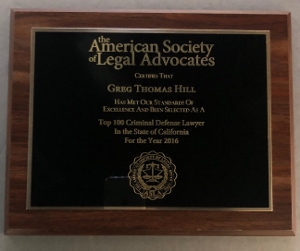In May, 2007, Costa Mesa Police learned that Reno Sifuentes, a convicted felon, was renting a room in a Santa Ana motel. The motel was notorious for drug dealing and prostitution on its premises. Since police knew there was an “outstanding no bail” parole arrest warrant, police requested and received a master key from the motel to Sifuentes’ room.
In a Nutshell: Conviction overturned for a felon in possession of firearm because constructive possession not proven.
After knocking, requesting entry and not any response, but seeing the window blinds sway from movement inside, police entered the room.
Police found Sifuentes laying on the bed. His friend, Juan Lopez, was standing beside another bed several feet away. There were also two partially clothed women in the room.
Police held down Sifuentes and demanded that Lopez raise his hands. Lopez, also a convicted felon, raised his hands very slowly, while looking down at a mattress on the bed near him (not Sifuentes’).
Police found a loaded .40 caliber semiautomatic handgun under the mattress, as well as methamphetamine and a pipe in Sifuentes’ pocket.
At trial, a gang expert testified that based on arrest reports and other police contacts over ten years, Sifuentes and Lopez were active member of Santa Ana’s Dehli street gang. Under police questioning, Sifuentes had denied being a current member, saying he had “moved on.” Lopez admitted such an association.

The gang expert also testified that “gang guns” are often shared among members “subject to certain restrictions.”
The jury convicted Sifuentes and Lopez of violating California Penal Code § 12021(a)(1), possession of a firearm by a felon, with a sentence enhancement under Penal Code § 186.22(b)(1) for being a gang member. Sifuentes was sentenced to twelve years; Lopez five.
Sifuentes then appealed his conviction (
People v. Sifuentes (2011 DJDAR 7786)), claiming he did not have construction possession of the .40 caliber, as had been the prosecution’s theory at the trial level. Sifuentes argued that the prosecution failed to prove he had “knowingly exercised a right to control” the gun either directly or indirectly through Lopez. Mere proximity, he argued, was not enough.
The Fourth Appellate District agreed, pointing out that the prosecution’s gang expert did not testify that every gun owned by a gang member entitled every other gang member to share in its use. The gang expert also failed to rule out “certain restrictions” did not act to limit Sifuentes' control over Lopez’ gun. The formal citation to the appellate court ruling is People v. Sifuentes (2011) 195 Cal.App.4th 1410.
 Fourth Appellate District Court
Fourth Appellate District Court
Consequently, the Court reversed the jury’s findings on the gun charge, as well as the gang enhancement, as it was based upon possessing the gun. Sifuentes was obviously a happy man.
Constructive possession is very often also an issue in drug possession cases, including possession for sales. The law on this is worth noting: constructive possession exists when someone maintains control or a right to control the contraband. Possession may be imputed when the contraband is found in a location which is immediately and exclusively accessible to the accused and subject to his dominion and control or which is subject to the joint dominion and control of the accused and another.
People v. Francis (1969) 71 Cal.2d 66, 71 [75 Cal.Rptr. 199, 450 P.2d 591]. In other words, possession can be charged even when someone shares possession of drugs with another person. Exclusive possession is not required.
However, when contraband is found in a place to which a defendant and others have access and over which none has exclusive control, no sharp line can be drawn to distinguish the facts which will and that which will not constitute sufficient evidence of a defendant ís knowledge of the presence of a narcotic.
People v. Hutchinson (1969) 71 Cal.2d 342, 345 [78 Cal.Rptr. 196, 455 P.2d 132].) [P]roof of mere opportunity of access to a place where narcotics are found, without more, will not support a finding of unlawful possession.
People v. Redrick (1961) 55 Cal.2d 282, 285 [10 Cal.Rptr. 823, 359 P.2d 255];
Williams v. Superior Court (1974) 38 Cal.App.3d 412, 422.
For more information about a felon in possession of a firearm and parole violations, click on the following articles:
- Conviction Upheld for Possession of an Assault Weapon, Although the Weapon Was Disassembled
- Prior Burglary Conviction Not a Predicate Offense to Enhance Defendant’s Federal Sentence for Felon in Possession of Firearm
- Woman Who Allowed Parolee to Stay at Her House Is Guilty of Being an Accessory in Assisting a Parolee Abscond from Supervision
For case summaries of selected cases our firm has handled, click
here.
Contact Greg Hill & Associates

 Fourth Appellate District Court
Fourth Appellate District Court